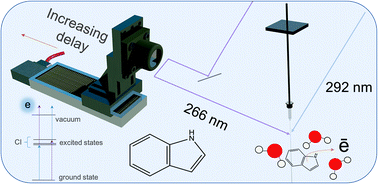Faraday Discussions, 212:359–381, Royal Society of Chemistry (RSC), 2018. 
![link The influence of aqueous solvent on the electronic structure and non-adiabatic dynamics of indole explored by liquid-jet photoelectron spectroscopy [link]](https://bibbase.org/img/filetypes/link.svg) Paper doi abstract bibtex 4 downloads
Paper doi abstract bibtex 4 downloads

![link The influence of aqueous solvent on the electronic structure and non-adiabatic dynamics of indole explored by liquid-jet photoelectron spectroscopy [link]](https://bibbase.org/img/filetypes/link.svg) Paper doi abstract bibtex 4 downloads
Paper doi abstract bibtex 4 downloads Understanding how the electronic structure of an aqueous solute is intricately bound up with the arrangement of a host liquid provides insight into how non-adiabatic photochemistry takes place in the condensed phase. For example, the presence of water provides additional solute–solvent interactions compared to non-polar solvents: changing the stability of ionized products and modifying the energies of low-lying excited valence states, as well as moving the point of intersection between potential surfaces. Thus, the locations and topography of conical intersections between these surfaces also change. The overall impact of the aqueous environment can be to modify the intricate photochemical and non-radiative pathways taking place after photoexcitation. Time-resolved photoelectron spectroscopy (TRPES) in a liquid micro-jet is implemented here to investigate the influence of water on the electronic structure and dynamics of indole, the chromophore of the amino acid tryptophan. TRPES is used to establish ultrafast relaxation pathways that vary as a function of excitation wavelength. In our experiment, aqueous indole was excited with femtosecond pulses centered at 292 nm and 266 nm. The vertical excitation energy of aqueous indole is extracted and found to be lowered by 0.5 eV in water relative to the gas phase. In the TRPES study, the spectral signature of 1La and evidence of solvated electron formation on an ultrafast timescale are observed. Our data also points to a possible contribution of the dissociative πσ* state, which can be accessed by a conical intersection (CI) with the 1La state.
@article{Kumar_2018,
doi = {10.1039/c8fd00123e},
url = {https://doi.org/10.1039%2Fc8fd00123e},
year = 2018,
publisher = {Royal Society of Chemistry ({RSC})},
volume = {212},
pages = {359--381},
author = {Gaurav Kumar and Anirban Roy and Ryan S. McMullen and Shanmukh Kutagulla and Stephen E. Bradforth},
title = {The influence of aqueous solvent on the electronic structure and non-adiabatic dynamics of indole explored by liquid-jet photoelectron spectroscopy},
journal = {Faraday Discussions},
abstract = {Understanding how the electronic structure of an aqueous solute is intricately bound up with the arrangement of a host liquid provides insight into how non-adiabatic photochemistry takes place in the condensed phase. For example, the presence of water provides additional solute–solvent interactions compared to non-polar solvents: changing the stability of ionized products and modifying the energies of low-lying excited valence states, as well as moving the point of intersection between potential surfaces. Thus, the locations and topography of conical intersections between these surfaces also change. The overall impact of the aqueous environment can be to modify the intricate photochemical and non-radiative pathways taking place after photoexcitation. Time-resolved photoelectron spectroscopy (TRPES) in a liquid micro-jet is implemented here to investigate the influence of water on the electronic structure and dynamics of indole, the chromophore of the amino acid tryptophan. TRPES is used to establish ultrafast relaxation pathways that vary as a function of excitation wavelength. In our experiment, aqueous indole was excited with femtosecond pulses centered at 292 nm and 266 nm. The vertical excitation energy of aqueous indole is extracted and found to be lowered by 0.5 eV in water relative to the gas phase. In the TRPES study, the spectral signature of 1La and evidence of solvated electron formation on an ultrafast timescale are observed. Our data also points to a possible contribution of the dissociative πσ* state, which can be accessed by a conical intersection (CI) with the 1La state.},
bibbase_note = {<img src="https://pubs.rsc.org/en/Image/Get?imageInfo.ImageType=GA&imageInfo.ImageIdentifier.ManuscriptID=C8FD00123E&imageInfo.ImageIdentifier.Year=2018">}
}Downloads: 4